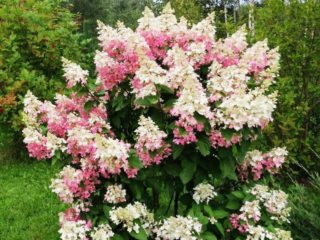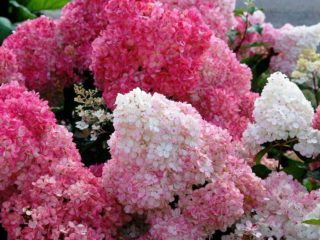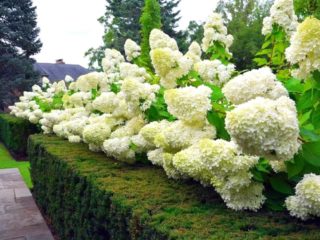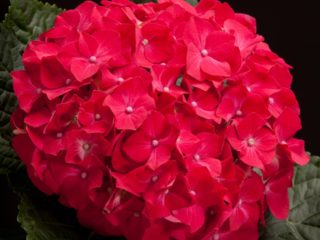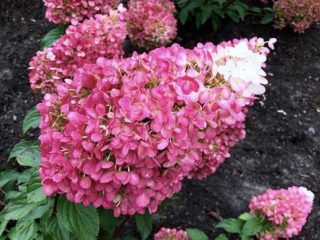Content
Hydrangea Earley Blue is a relatively young variety, bred by Dutch breeders in 2006. Lush blooms, longevity and good disease resistance are the hallmarks of this variety. The frost resistance of the variety is average.
Description of hydrangea Airlie Blue
Large-leaved hydrangea Earley Blue (Early Blue) is a medium-sized ornamental shrub with a spherical crown type. The plant can reach a height of 100-120 cm, the diameter of the bushes is also about 120 cm.The lifespan of the plant is 18-20 years.
The Erly Blue hydrangea blooms on last year's shoots and the current year's shoots, forming lush spherical inflorescences. The size of each of them can reach 20-30 cm. The color of the flowers varies from blue to purple-pink tones, and flowering lasts from July to September.
The leaves of the Earley Blue variety are large, serrated at the edges. The surface of the plate is smooth to the touch, shiny. The color is dark green.

The flowers of the variety are collected in rather dense inflorescences
Hydrangea Earley Blue in landscape design
The scope of the variety is quite versatile. Hydrangea Earley Blue is perfect for both solitary plantings and group compositions. You can grow shrubs in bed and rockeries.
A distinctive feature of the Earley Blue variety is a developed root system. This quality allows it to be planted in containers, which are removed indoors for the winter.

The base of the flower bed can be planted with low-growing crops, which will act as edging
Winter hardiness of hydrangea Earley Blue
The winter hardiness of this garden culture is average. Hydrangea Earley Blue winters safely in regions with a warm climate without shelter, however, in the middle and northern latitudes, it is better to cover the bushes with the onset of cold weather.
You can cover the plantings with spruce branches and agrofibre, having previously tied the shoots together. Young seedlings are sprinkled with fallen leaves and sawdust. Older plants sometimes need to be bent to the ground, but this should be done very carefully so as not to break the shoots.
Planting and caring for hydrangea large-leaved Airlie Blue
The planting process for the Earley Blue hydrangea includes the most standard procedures. Taking care of the plant is also easy - the whole process comes down to timely watering and feeding. The bushes should be cut once or twice a season.
Selection and preparation of the landing site
Preference should be given to well-lit areas, but plants should not be under the scorching sun all day. The shrub develops best in conditions of moderate shade.
The recommended soil type is acidic and semi-acidic. The high content of lime in the soil can provoke the development of a number of diseases.
A few weeks before planting the hydrangea, it is recommended to dig up the area chosen for the flower bed and correct its composition. To do this, a mixture of humus, peat, leafy earth and river sand is introduced into the soil in a ratio of 2: 1: 2: 1.
If the acidity of the soil is higher than 4, the seedlings will form pink flowers. In order for them to be blue, the soil is acidified with potassium alum once a week. You can also change the color of flowers by adding iron filings to the area of the trunk circle.
Landing rules
Airlie Blue hydrangea is planted according to the following scheme:
- First, dig a hole about 50 cm deep and about 40 cm in diameter.
- If the soil on the site is clay, then drainage must be placed on the bottom of the dug hole: small pebbles, expanded clay, broken brick.
- Then the pit is filled with a mixture of fallen needles, humus, high peat and light garden soil in a ratio of 1: 1: 2: 2. If before that the site was dug up with the addition of fertilizers, the amount of garden land in this composition is increased to half of the total volume.
- After that, the hydrangea seedling is dipped in a container of water for a couple of hours.
- The prepared planting material must be placed in the center of the pit so that its neck is not very deep. Sprinkle the root system with the rest of the soil mixture.
- Then the area of the trunk circle is lightly tamped so that the roots are well pressed, and no voids are formed around them.
- The soil compacted under the plant is generously watered.
- Complete the planting procedure with mulching. To do this, use fallen needles, wood chips or peat.
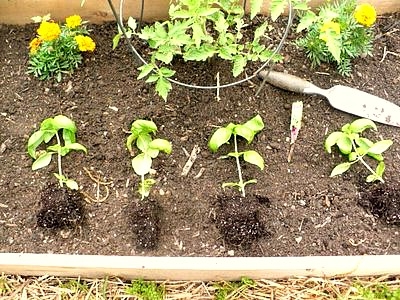
Recommended planting pattern for hydrangea - 1x1 m
Watering and feeding
In order for the Earley Blue variety to bloom luxuriantly, the shrub needs a lot of moisture - the soil around the plant should not dry out and crack. Otherwise, they are guided by local climatic conditions. In this case, it is best to take settled rainwater from a barrel standing in the sun for watering hydrangea.
Too hard water soften with a little citric acid.
If the hydrangea has formed pink flowers, the water for irrigation is diluted with potassium alum (5 g of substance per 2 liters of water). You can also use special formulations to acidify the soil.

Effectively oxidizes the Acid plus soil
The first feeding of the Earley Blue variety is carried out in the spring. For these purposes, it is better to use special mineral complexes designed for hydrangeas. The second feeding is carried out during the flowering period. The third - in September, shortly before the end of flowering. Additionally, humus can be added under the hydrangea.
If the pink color of the flowers is preferable to blue, then maintaining the alkalinity of the soil will help to preserve it. To do this, wood ash is poured under the bushes and the plantings are watered with a solution based on dolomite flour.
Pruning hydrangea large-leaved Airlie Blue
It is better not to cut the hydrangea for the first 2-3 years. Only dried branches are removed.
When the bushes grow up, pruning is carried out to the first living bud, cutting off the old inflorescences that were left to winter. According to the season, it is better to form a hydrangea in the spring.
Preparing for winter
Preparation for the winter season begins by spraying the bushes with Bordeaux liquid - this will prevent the plants from drying out under the shelter. Then they act according to the following scheme:
- The area of the trunk circle is sprinkled with peat, so that a small hill is formed.
- Spruce branches are placed on this elevation.
- If the shoots of the shrub are high, then they must be carefully bent to the ground and securely fixed in place. For this, you can use a wire frame.
- A non-woven material is placed on top of the bent branches and sprinkled with compost soil.
- To protect against precipitation, the hydrangea is covered with roofing material.
If the branches of the bush have become too rigid, and it will no longer be possible to bend them, it is better to tie them together, shifting the spruce branches. Then this bundle is wrapped with agrofibre and film.
Reproduction
The Earley Blue variety is propagated by dividing the bush, layering, root suckers and summer cuttings. One of the easiest breeding methods is to create layering.
The whole process in this case looks like this:
- In early May, several rather flexible branches are bent away from an adult bush.
- The ends of the shoots are fixed in a small depression on the ground. Additionally, they are secured in a bent position using small metal staples. The hole should be approximately 15 cm deep.
- Where the shoots come into contact with the ground, the leaves are peeled off them. It is also recommended to scrape this section of the branches with a knife in order to "start" the process of root formation.
- After that, the hole is covered with earth.
From time to time, the layering is watered, carefully preserving the moisture content of the soil. By the fall, they should form their root system, then they are cut off and planted for wintering in containers. Landing in a permanent place is carried out in the spring of next year.
Diseases and pests
The hydrangea of Earley Blue is ill infrequently, but occasionally plantings can infect a fungus, infectious diseases and pests.
If the leaves of the shrub suddenly began to turn yellow, but the veins on them remain green, this means that the plantings were struck by chlorosis.
Additional symptoms:
- curling leaves along the edge;
- falling foliage;
- deformation of buds;
- drying of the shoots at the ends.
Chlorosis in hydrangea it develops if the shrub was planted in an area with alkaline soil. To eliminate the symptoms, it is necessary to increase the acidity of the soil with solutions with the addition of potassium nitrate.
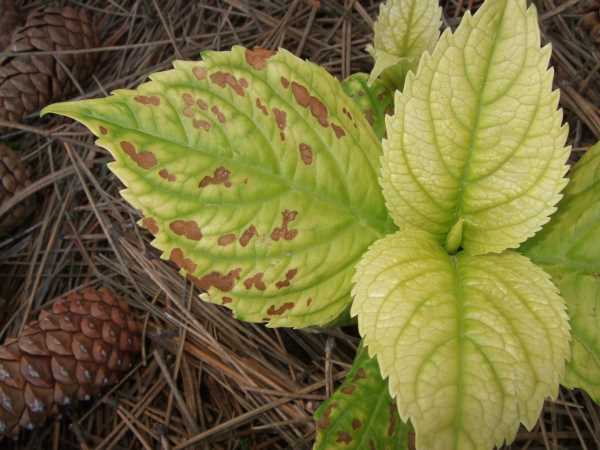
For the treatment of chlorosis, you can use top dressing with iron sulfate.
Downy mildew - another dangerous disease to which the Earley Blue variety is vulnerable. You can determine the ailment by the oily spots on the leaves of the hydrangea, which eventually acquire a yellow color. In the later stages of the disease, the affected areas of the leaf plate darken.
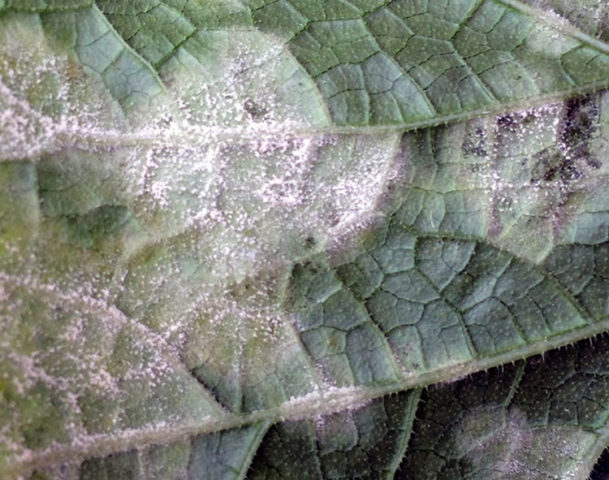
Planting treatment is carried out using any fungicidal agents
If the shrub suddenly begins to turn yellow, you should carefully examine the leaves of the plant from the bottom side. If they are covered with thin cobwebs, it means that a spider mite has hit the flower bed. Any insecticide from a gardening store will help to cope with the pest.
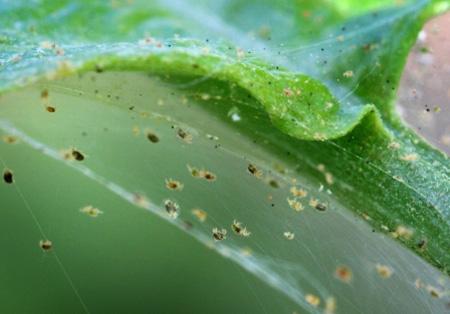
Well proven in the fight against spider mites Actellik
Conclusion
Hydrangea Earley Blue is a very unpretentious shrub with medium frost resistance, which is perfect for planting in central Russia. The inflorescences of the variety can be used for cutting and drawing up dry bouquets.
In addition, you can learn how to grow a hydrangea of the Earley Blue variety from the video:
